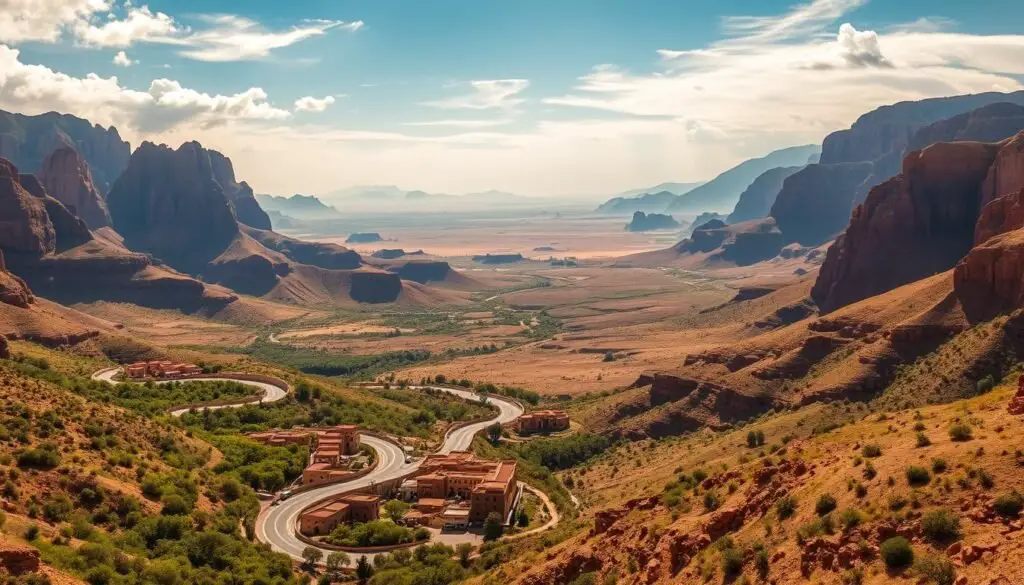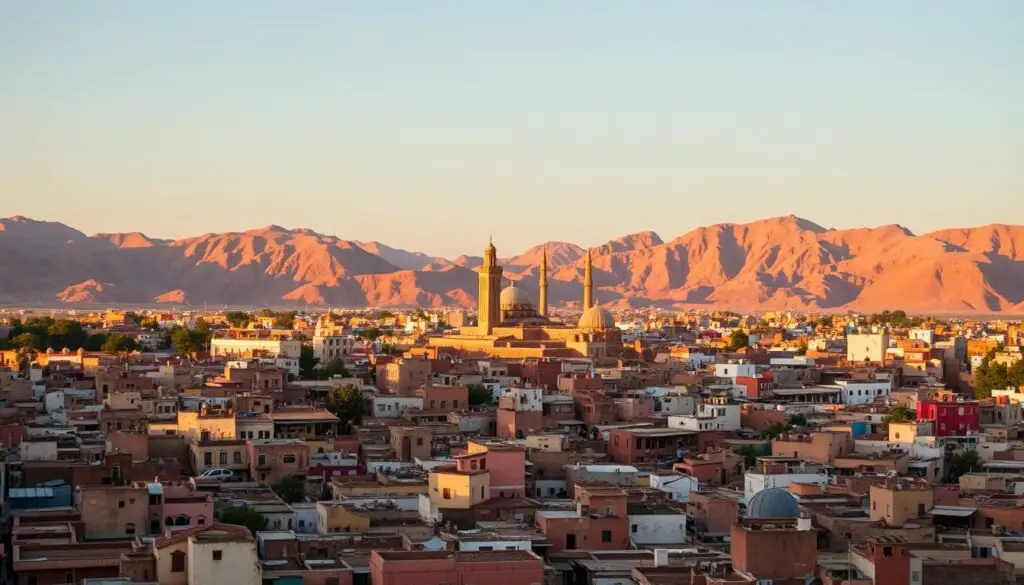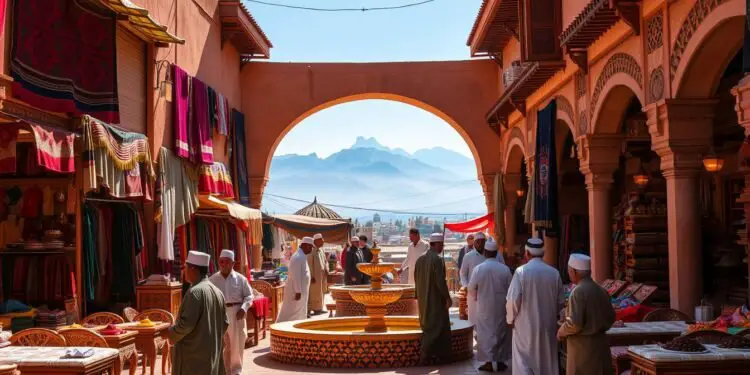Have you ever wondered how a single country can seamlessly blend the charm of coastal cities, the majesty of mountain ranges, and the mystery of vast deserts? Morocco is that destination, offering a sensory journey like no other.
This North African gem is a melting pot of influences. From the ancient Berber traditions to the Arab conquests and colonial legacies, Morocco’s culture is a vibrant tapestry. Its history is equally fascinating, with imperial cities, UNESCO-listed medinas, and architectural wonders that tell stories of dynasties and conquests.
Whether you’re drawn to the bustling souks of Marrakech, the blue streets of Chefchaouen, or the serene landscapes of the Atlas Mountains, Morocco promises an unforgettable experience. Let’s explore what makes this country a must-visit for every traveler.
Key Takeaways
- Morocco offers diverse landscapes, from coastal areas to deserts and mountains.
- The culture is a blend of Berber, Arab, and colonial influences.
- Imperial cities and UNESCO medinas are key attractions.
- The country’s history is rich with dynasties and architectural marvels.
- Morocco is a sensory wonderland for travelers seeking unique experiences.
Morocco’s Diverse and Breathtaking Landscapes
From rugged mountains to golden deserts, Morocco’s scenery is as diverse as it is breathtaking. This North African gem offers a mix of natural wonders that cater to adventurers, nature lovers, and beachgoers alike.

The Majestic High Atlas Mountains
The High Atlas Mountains stretch over 1,000 kilometers, with peaks reaching 13,672 feet. Known as Idraren Draren or “Mountain of Mountains,” this range is a haven for hikers and nature enthusiasts. Trails lead to hidden gems like Lac Ifni and traditional Berber villages, offering a glimpse into local culture.
For thrill-seekers, Oukaimeden, Africa’s highest ski resort, sits at elevations between 2,600 and 3,200 meters. The area is also home to Toubkal Peak, the highest point in North Africa at 4,167 meters, surrounded by rich biodiversity.
The Enchanting Sahara Desert
To the southeast lies the Sahara Desert, a sea of wind-swept dunes that captivate the imagination. Camel treks through the Erg Chebbi dunes near Merzouga are a must, offering an unforgettable journey into the heart of the desert.
Overnight camping under the stars provides a magical experience, with clear night skies and the silence of the desert creating a serene atmosphere. Nearby, the UNESCO-listed Ait Ben Haddou adds a historical dimension to this stunning landscape.
Stunning Coastal Beaches
Morocco’s 1,930-kilometer coastline is a paradise for beach lovers. Essaouira, a prime destination, offers a mix of relaxation and water sports, including surfing. The Atlantic and Mediterranean shores feature secluded bays and vibrant marine life, making it a perfect escape.
Legzira Beach, known for its natural arches, and the pristine waters near al-Hoceima National Park highlight the country’s coastal beauty. Whether you’re looking to surf, swim, or simply unwind, Morocco’s beaches have something for everyone.
Interesting Things About Morocco: Its Unique Cities
Morocco’s cities are a testament to its rich history and cultural diversity. Each city offers a unique blend of ancient traditions and modern life, making them a must-visit for travelers. From imperial capitals to medieval wonders, these urban centers tell the story of a nation shaped by centuries of influence.

The Imperial Cities: Rabat, Marrakesh, Meknes, and Fez
Morocco’s four imperial cities—Rabat, Marrakesh, Meknes, and Fez—each served as the capital at different points in history. Rabat, the current capital, combines modern governance with ancient ruins like the Chellah Necropolis. Marrakesh, known as the “Red City,” boasts red sandstone buildings and bustling markets. Meknes is famed for its royal granaries and monumental gates, while Fez, established in the 9th century, is a medieval marvel.
Marrakesh: The Red City
Marrakesh is a sensory wonderland. Its nickname, the “Red City,” comes from the distinctive red sandstone used in its architecture. The heart of the city is Jemaa el-Fna square, a UNESCO-listed site dating back to 1062. Here, you’ll find snake charmers, street performers, and vibrant markets. The medina, with its labyrinthine alleys, is a treasure trove of traditional crafts and spices.
Fez: The World’s Oldest Medieval City
Fez is one of the world’s oldest medieval cities, with a history that spans over a millennium. Its medina, enclosed by 10-mile walls, features over 10,000 car-free alleys. This UNESCO World Heritage site is home to Al Quaraouiyine University, founded in 859 AD, the oldest continually operating university in the world. Fez’s cultural significance and historic charm make it a must-see.
Morocco’s Rich Cultural Tapestry
Morocco’s cultural identity is a vibrant blend of ancient traditions and modern influences. This North African nation is home to a diverse population, with the Amazigh people playing a significant role in shaping its heritage. From their nomadic roots to their enduring traditions, the Amazigh have left an indelible mark on Moroccan culture.
The Amazigh (Berber) Influence
The Amazigh, often referred to as Berbers, make up about 40% of Morocco’s population. Their name means “free people,” reflecting their independent spirit. They have preserved their languages, including Tamazight, Tashelhit, and Tarifit, which are still spoken today. Traditional music like ahidus and Gnawa reflects their rich heritage, often performed at social gatherings.
Amazigh communities in the Atlas Mountains and Souss Valley maintain their customs, from intricate crafts to communal celebrations. Their influence is also evident in Moroccan food, with dishes like couscous and tagine rooted in their culinary traditions.
The Art of Moroccan Hospitality
Moroccan hospitality is legendary, deeply rooted in the values of family and community. Guests are often welcomed with a glass of mint tea, a symbol of warmth and friendship. This ritual is a cornerstone of Moroccan culture, showcasing the importance of connection.
In riads, traditional Moroccan homes, dinners are often served communally around low tables. Live music and storytelling create a festive atmosphere, making every meal a memorable experience. This emphasis on togetherness highlights the Moroccan way of life.
Traditional Moroccan Cuisine
Moroccan food is a feast for the senses, blending flavors from Amazigh, Arab, and Andalusian traditions. Spice markets are central to this culinary culture, offering ingredients like saffron, cumin, and cinnamon. These spices elevate dishes like tagine, a slow-cooked stew, and couscous, a staple of Moroccan meals.
Pastries like makrout, made with dates and honey, are a sweet treat often shared with friends and family. The use of fresh, local ingredients ensures every dish is bursting with flavor, making Moroccan cuisine a highlight of any visit.
Unusual and Surprising Facts About Morocco
Morocco is a land of surprises, where tradition meets the unexpected. Beyond its iconic landscapes and vibrant culture, this North African nation holds secrets that fascinate and intrigue. From unique cultural expressions to historical milestones, here are some lesser-known facts morocco has to offer.
Africa’s Highest Ski Resort
Nestled in the High Atlas Mountains, Oukaimeden is Africa’s highest ski resort, reaching elevations of 3,200 meters. Built in the 1940s with military-installed ski lifts, it boasts 20 slopes catering to both beginners and advanced skiers. Just 80 kilometers from Marrakesh, this resort offers a unique blend of adventure and stunning mountain views.
Oukaimeden’s infrastructure, including its historic lifts, adds to its charm. It’s a testament to Morocco’s diversity, where you can ski in the morning and explore the desert by evening.
The Liver as a Symbol of Love
In Moroccan culture, the liver holds a special place as a symbol of love. Expressions like “Thssa Ino” (Tamazight) and “Lkbida diali” (Darija) translate to “my liver,” conveying deep affection. This contrasts with the Western metaphor of the heart, showcasing the unique ways emotions are expressed in Morocco.
This cultural nuance highlights the richness of Moroccan traditions, where even body parts carry profound meanings.
The Only Jewish Museum in the Arab World
Located in Casablanca, the Jewish Museum is the only one of its kind in the Arab world. It documents Jewish settlements dating back to the 2nd century BC and showcases the shared history of Judeo-Muslim communities. Exhibits include textiles, clothing, and artifacts that reflect mutual cultural influences.
The museum stands as a symbol of Morocco’s commitment to preserving its multicultural heritage. It’s a must-visit for those interested in the state’s historical and cultural tapestry.
Conclusion
Morocco’s allure lies in its perfect harmony of ancient traditions and breathtaking landscapes. From the golden dunes of the Sahara to the vibrant souks of Marrakech, this guide highlights the beauty of a trip to this North African gem. For the best experience, plan your visit during the cooler months of fall or spring, ideal for exploring the desert and cities alike.
Consider curated tours to navigate the intricate medinas and uncover hidden gems. Immerse yourself in local culture through tea ceremonies and bustling markets. These experiences offer a deeper connection to Morocco’s rich heritage.
Share your travel stories in the comments and inspire others to embark on their own Moroccan adventure. Now is the perfect time to discover this captivating destination.
FAQ
What makes the High Atlas Mountains unique?
The High Atlas Mountains are known for their towering peaks, including Mount Toubkal, North Africa’s highest point. They offer breathtaking scenery, trekking opportunities, and the highest ski resort in Africa, Oukaïmeden.
Why is the Sahara Desert a must-visit in Morocco?
The Sahara Desert is a mesmerizing landscape of golden dunes, starry nights, and unique experiences like camel treks and desert camping. It’s a place of unparalleled beauty and tranquility.
What are the Imperial Cities of Morocco?
The Imperial Cities—Rabat, Marrakesh, Meknes, and Fez—are historic capitals known for their rich history, stunning architecture, and cultural significance. Each city offers a unique glimpse into Morocco’s past.
What is special about Marrakesh?
Marrakesh, often called the Red City, is famous for its vibrant souks, the iconic Jemaa el-Fnaa square, and stunning landmarks like the Bahia Palace and Koutoubia Mosque.
Why is Fez considered the world’s oldest medieval city?
Fez is home to the world’s oldest university, Al Quaraouiyine, and its medina, a UNESCO World Heritage Site, remains one of the best-preserved medieval cities globally.
How does Amazigh culture influence Morocco?
The Amazigh (Berber) people have shaped Morocco’s language, traditions, and art. Their influence is evident in everything from music and crafts to architecture and cuisine.
What is traditional Moroccan cuisine known for?
Moroccan cuisine is famous for dishes like couscous, tagine, and pastilla. It’s a flavorful blend of spices, fresh ingredients, and centuries-old cooking techniques.
Where is Africa’s highest ski resort located?
Oukaïmeden, located in the High Atlas Mountains, is Africa’s highest ski resort, offering skiing and snowboarding with stunning mountain views.
What is the significance of the liver in Moroccan culture?
In Moroccan tradition, the liver is considered a symbol of love and affection, often referenced in poetry and folklore.
Why is the Jewish Museum in Casablanca unique?
The Jewish Museum in Casablanca is the only museum dedicated to Jewish heritage in the Arab world, showcasing the rich history and contributions of Morocco’s Jewish community.




